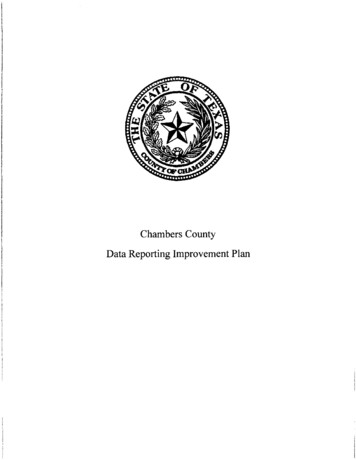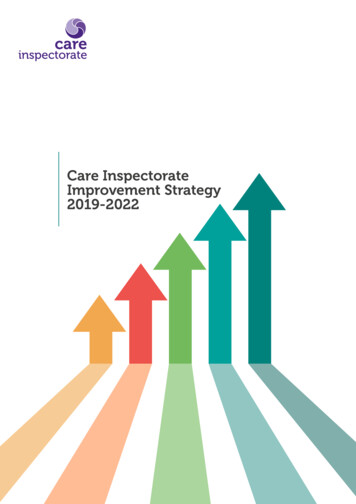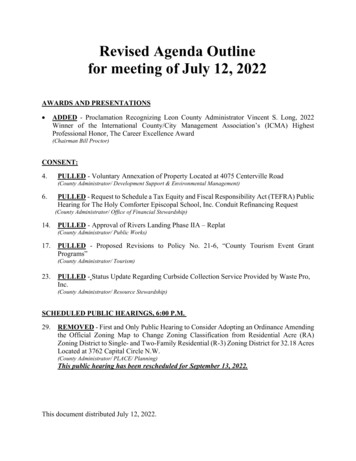
Transcription
1iChambers CountyData Reporting Improvement Plan
lil1I1Section I- Legislative RequirementIlI!Chapter 60.1 0, Code of Criminal Procedure (CCP) creates provisions regarding adata reporting improvement plan applicable to a county that has an averagedisposition completeness percentage, including both juvenile and adultdispositions, of less than 90 percent. The statute requires the Commissioners Courtof such a county to establish a local data advisory board, as described by state law,not later than November 1, 2009. The bill sets forth the persons authorized andrequired to be included in such a local data advisory board. The statute requires alocal data advisory board to prepare a data reporting improvement plan, in additionto other duties prescribed by law, and requires the plan to describe the manner inwhich the county intends to improve the county's disposition completenesspercentage; ensure that the county takes the steps necessary for the county'saverage disposition completeness percentage to be equal to or greater than 90percent in the first report DPS submits to certain state officers and agenciesregarding local jurisdiction reporting on or after January 1, 2013; and include acomprehensive strategy by which the county will permanently maintain thecounty's disposition completeness percentage at or above 90 percent. The statuterequires a local data advisory board established under the bill's provisions, not laterthan June I, 2010, to submit to DPS the data reporting improvement plan preparedfor the county. DPS, on receipt of a data reporting improvement plan, is requiredto post the plan on the DPS Internet website. The statute authorizes the publicsafety director ofDPS to adopt rules concerning the contents and form of a datareporting improvement plan.In compliance with this statute, the Chambers County Commissioners Courtestablished a local data advisory board on September 08, 2009.It is the goal of this advisory board to develop and implement procedures to ensureaccurate and complete reporting of all reportable arrests, prosecutor actions, andcourt dispositions that occur in the county.
Section II- Composition of the Local Advisory Board MembersThe Board consists of the following members, selected using the requirements ofChapter 60.1 0, CCP. The Commissioners Court chose to create the board using theposition titles outlined in Chapter 60, rather than appointing specific individuals tothe board. These positions and the individuals filling them are listed below.Required MembersThe Chambers County CJIS Advisory Board shall consist of :1.2.3.4.5.6.7.SheriffJoe LaRiveDistrict Attorney Cheryl LieckCounty Attorney Scott PealDistrict Clerk Patti HenryCounty Clerk Heather HawthorneMont Belvieu Police Chief Virgil BlasdelNet Data Corp representativeAdditional input was contributed from the following persons responsible forcollecting, storing, reporting, and using data; however, they were not appointed asboard members by the Commissioners Court.Bea Blue, Juvenile ProbationGloria Turner, Juvenile ProbationJeanette Rhame, District Clerk's OfficeSheri Hemphill, County Clerk's OfficeRobin Edmonds, County Clerk's OfficeAmy Tapp, District Attorney's OfficeCaptain Larry Cook, Sheriffs OfficeShari Phelps, Adult ProbationTammy Yarter, Chambers County IT DirectorMarangely Barrett, County Attorney's OfficeAny vacancies occurring on the board will be replaced by nomination and popularvote of the remaining members of the board.
The first meeting of the board took place on October 6, 2009 where members wereeducated on the issue and problems were discussed in order to complete the planand bring the county into compliance. Subsequent meetings and discussions wereheld and the plan was created.Section III - Current Process Supporting the Chapter 60 ReportingRequirementsWhenever a reportable arrest takes place in Chambers County, the jail fingerprintsthe arrestee on an electronic fingerprint system which creates a tracking number(TRN). This tracking number is used by the prosecutor of the case to submitwhether the case is accepted or rejected, and by the court to submit the final casedisposition to the Department of Public Safety Computerized Criminal Historysystem (DPS CCH). Certain key functions have been identified by DPS and areexamined below along with a more detailed description of the reporting process.How the DPS Incident Tracking Number (TRN) and Tracking Number Suffix(TRS) are introduced into and maintained throughout the flow of informationAll Class B Misdemeanor, Class A Misdemeanor, and Felony arrests for offensesidentified by DPS as reportable offenses and made in Chambers County on localwarrants or on-view arrests are reported to DPS so they may be included in theperson's computerized criminal history (CCH). The officer making the arrestcompletes a Probable Cause sheet which lists the specific DPS offense code for thecharge on which the individual is arrested. This sheet is given to the jailer whouses this form to enter the charge information into Menatlix, a computerizedfingerprint system which creates the initial tracking number (TRN) for the arrestand electronically transmits the arrest data to DPS. This tracking number is passedto each department that deals with the case in paper format, either on the originalCR43 printed out at the jail or by a screen print from the DPS Electronic DataReporting (EDR) website. The TRN is also entered into Chambers County's casemanagement system (Net Data) and attached to the arrest, so any department canverify this number even if the paper copy is not readily available.
1IllJHow persons arrested on out of county warrants are processedSince the agency issuing the warrant is responsible for submitting the arrestinformation to DPS, no information is sent to DPS by Chambers County when anout of county warrant is served. Individuals arrested on warrants from othercounties are ink fingerprinted, and these fingerprints are picked up by the JailCaptain, who starts a carbon copy CR43. This CR43 is sent to the warrant holderalong with the fingerprints and the defendant or bond paperwork. This allows thewarrant holder to complete the CR43 and submit the information by mail to DPS.How persons arrested out of county on in-county warrants are processedIf an individual is arrested out of county on a local warrant, one of two cases mayoccur. If the arrestee does not bond out and Chambers County picks the subject up,he is booked in to the Chambers County jail when he arrives and the arrest issubmitted to DPS through Menatlix just as someone arrested on a local warrant. If,however, the arrestee bonds out before being transferred to Chambers County, theJail Captain will receive the paperwork from the arresting agency. This paperworkshould, but seldom does contain a fingerprint card and partially completed CR43.Due to fact that the CR43 is rarely received with this paperwork and thefingerprints, if received, are usually poor quality, no information is submitted toDPS by our county from this paperwork. In addition, this paperwork would have tobe mailed in, which causes lengthy delays and no tracking ability to verify theinformation has been submitted until it appears in DPS records, which may take inexcess of 45 days.If the defendant was arrested out of county on a local warrant, there is generally nopaperwork delivered to the prosecutor's office. The only notice received by theprosecutor comes from the court that the arrest was made and the case needs to beset for a hearing. Law enforcement does not send any information to theprosecutor. These arrests are not in DPS records until the defendant is fingerprintedand the arrest transmitted to DPS on the first court appearance. For misdemeanorCounty Court cases the case is flagged in our County Attorney's office casemanagement system and the person is fingerprinted and the arrest submitted toDPS through the Menatlix system the first time the person appears in court.Currently felony case arrestees do not get fingerprinted until they are indicted orplaced on probation. Once indicted, they will usually be fingerprinted and the
!IlIIIlIIIlarrest information will be transmitted to DPS through Menatlix. If the individual isplaced on probation and no arrest information can be found in DPS records, theprobation department will have the person fingerprinted and will fill out a CR43Ppaper form and mail that in to DPS.How added charges are dealt with so that they receive an appropriate TRSand reported to the next county entity and to the DPSIf there are multiple charges at the time of arrest, these are all entered on the samearrest TRN with different tracking suffixes (TRS), then the fingerprints are takenand the charges are transmitted to DPS. The TRS's are created by thefingerprinting software. If charges are added by the officers at a later time, theseare submitted to the prosecutor as a separate case, and the prosecutor is responsiblefor submitting the new charge, if accepted, to DPS. If a new charge arises out ofthe same incident, it will be added to the TRN already created during the arrest. Ifa charge is added by the prosecutor's office to an existing arrest, that charge issubmitted to the local case management system by the prosecutor's ens entryperson just before the case is sent to the County or District Clerk's Office. Twopaper copies of the ens record are printed from the website after submission. Onecopy is placed in the case file in the prosecutor's office, and the other copy isforwarded to the County or District Clerk's Office. The TRN information foradded charges is put in the local case management system by the County Clerk forCounty cases, if possible.How charges disposed by the arresting agency or prosecutor are reported tothe next county agency and to the DPSChambers County policy is that any on-view arrest will be submitted to theappropriate prosecutor as a case for review. If the arresting agency does not wish topursue the case, they will still submit it to the prosecutor with that informationattached. The prosecutor is then responsible for submitting the arrest dispositionthrough the DPS EDR website. These cases may be reported as dropped byarresting agency or rejected by prosecutor, but will be submitted to DPS by theprosecutor's office.
Non-reportable arrests that are submitted to DPS in error are sent to the CountyAttorney's CJIS Administrator to have the arrest closed out as charges dropped,submitted in error.How each agency ensures that all charges are reported to the next countydepartment and to the DPSOn each arrest made and transmitted through Menatlix, three paper copies of thearrest record (CR43) were printed, and these copies were placed in the defendant'sjail folder. The jailer also manually entered the booking information into ChambersCounty's case management system, Net Data.The County Attorney's Office receives notice of arrest on a new case by paperform (CR43/CR44) that is delivered with the new case from law enforcement. Forany cases that arrive without a CJIS form or the bond, the local case managementsystem can be reviewed to verify if a local arrest took place. TRN informationentered in the jail in the case management software (Net Data) by the lawenforcement can be viewed by the County Attorney's Office.The paper CJIS form is kept with the case as it is reviewed in the CountyAttorney's Office. When the case is accepted or rejected it is, by recentlyestablished procedure, given to the CJIS entry person in the County Attorney'sOffice and the prosecutor action is submitted the case management system. If thecase is rejected, no notification of the County Court occurs; however, the CountyClerk's office is notified by email for bond and case management purposes. If thecase is filed (accepted), two paper copies of the CJIS record are printed from thecase management system after submission. One copy is kept in the case file in theprosecutor's office, and the other copy is attached as a cover page on thepaperwork delivered to the County Clerk's Office.Both the County Clerk and District Clerk in Chambers County receive TRNinformation by paper screen print from the case management system printed out bythe prosecutor's office. For on-view arrests, these paper forms are delivered with
the case after it has been accepted on County Court cases, or after indictment onDistrict Court cases. For arrests on local warrants, the Clerk receives the DPS EDRwebsite screen print from the prosecutor as soon as the prosecutor receives theCR43 and accepts the charge on the DPS EDR website. TRN information enteredon the jailing in the case management software by the law enforcementadministrative assistant can be viewed by the County and District Clerk's Officesto verify this information. Both the County and District Clerks submit the finaldisposition of their cases to DPS using the DPS EDR website. Any amendments toprobation terms or deferrals are also submitted by this website, allowingdispositions to appear almost instantly in the person's CCH.Juvenile cases are forwarded by paper form (CR-43J) from one Sergeant with theChambers County Sheriffs Office or one officer with the Mont Belvieu PoliceDepartment to the Chambers County Juvenile Probation Officer. The probationofficer then fills in the intake, prosecutor and court sections of the CR-43J. Thispaperwork is held until the case has been disposed. The probation officer thenforwards the paper copy with the court disposition to the County Clerk's officewhere the information is submitted electronically to DPS.Section IV Identify problem areas associated with compliance to Chapter 60reporting requirementsThe statute places responsibility on specific local agencies to be compliant withChapter 60.The Advisory Board identified that lack ofcommunication between agencies anddepartments has been an issue in the past regarding reporting issues. The Boardpledged that each department must be thorough and accurate with the data entry asto avoid problems in the flow of information at the local level in order to besuccessful in reporting to the state. The Board also recognized that communicationbetween each link in the system needed to be monthly. The County Clerk's officewould generate the DPS report and then communicate monthly with alldepartments to find the gaps in the reporting issues.
The Board also acknowledged the lack of training and education withindepartments of procedures that ensure accurate reporting. Each departmentpledged to give those employees the training necessary to be successful in CCHreporting. For example, jailers needed to have the correct offense code to report toDPS from the time of the arrest so the reporting would be accurate from the onset.Also, jailers needed to be trained on the problems with the Menatlix system and thenon-transmittal of information to DPS. In many cases, the information never leftthe local computer. Jailers needed to be trained to check the return file to verifythe information was transmitted successfully.Lastly, the Board identified that systems and procedures in place in 2006 when thenumbers were generated for the legislature, have been updated to prevent theseproblems. Many of the issues identified and solutions to the issues were put inplace before the creation of the Board.Section V The PlanThe Advisory Board was instrumental in bringing all departments and agenciestogether to discuss and develop procedure changes. Changes have been made insoftware, training and reporting procedures. All departments are now able to vieweach arrestee from jail book-in to disposition in our local case management system.Chambers County is dedicated to maintain compliance and continually improve onthe accuracy of data submitted to the DPS.
fingerprinting software. If charges are added by the officers at a later time, these are submitted to the prosecutor as a separate case, and the prosecutor is responsible . submitted to the local case management system by the prosecutor's . ens . entry person just before the case is sent to the County or District Clerk's Office. Two paper .











